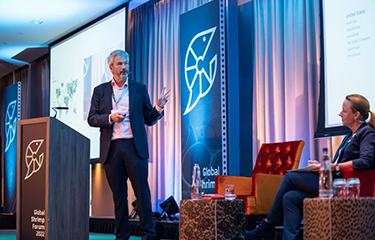Animal welfare and sustainability will become critical issues the global shrimp sector has to pay more attention to, according to a leading shrimp industry expert.
During the Global Shrimp Forum in September 2022, Ahold Delhaize Vice President of Product Integrity Hugo Byrnes said shrimp consumers around the world are increasingly interested in sustainability and animal welfare issues.
“It’s time for the shrimp industry to wake up to the fact that certification alone is no longer sufficient,” Byrnes said. “It will take more to comply with future regulations and additional buyer requirements.”
While many sustainability metrics are included in third-party certification programs such as Best Aquaculture Practices (BAP), Aquaculture Stewardship Council (ASC), and GlobalG.A.P, the inclusion of animal welfare requirements in these certifications remains modest, Willem van der Pijl, the founder of consultancy Shrimp Insights, revealed in a recent blog post. Humane slaughter and eyestalk ablation are two recent issues that have received public attention recently, and van der Pijl said it’s just a matter of time before shrimp producers are forced to address them.
While it is not scientifically clear whether shrimp feel pain as fish do, Hilton Foods, a supplier of seafood products to the U.K.’s largest food retailer Tesco, has taken steps toward a more humane approach toward shrimp harvesting through a pilot use of electrical stunning in its shrimp supply chain. According to van der Pijl, electric stunning of shrimp is considered too expensive and burdensome to enable widespread implementation, but companies should start thinking about how they might tackle the issue if retailers or consumers raise it as a problem.
“Whether electrical stunning becomes the method of choice is not yet clear. But what is very clear to me for one is that we have to prepare ourselves for more discussion and debate about this topic in the future,” van der Pijl said.
Likewise, eyestalk ablation, or the removal of one or both eyestalks from a crustacean, has received much attention from the public, especially in northern Europe. A popular Dutch TV show recently reported on the use of eyestalk ablation in a hatchery in Thailand, where the eye of a female breeder was cut by a worker’s heated scissors, with the shrimp seen twitching before it was returned to its tank. Though this practice is limited to use on post-larvae-producing females so they will spawn more eggs, helping hatcheries reduce the number of breeders, according to van der Pijl, retailers in the Netherlands and other parts of Europe may see the process as a reputational risk.
In fact, there are moves to ban the eyestalk ablation in the shrimp industry. Some Ahold Delhaize supermarkets are now requiring the shrimp they sell to be produced without the use of ablation in the production process, Byrnes said. The E.U. has also prohibited the use of eyestalk ablation for several years under its organic standard, and GlobalG.A.P. will prohibit eyestalk ablation beginning in 2024.
In regard to sustainability, the big push being made by retailers is toward a reduction in greenhouse gas emissions in their supply chains. Ahold Delhaize, for example, has pledged to reduce its emissions by 15 percent by 2030 from a 2018 baseline, and has set the goal of achieving net-zero emissions by 2050. The company is also targeting a reduction in its scope-3 emissions – encompassing emissions that are not produced by Ahold Delhaize itself – in line with a science-based roadmap to keep the global warming below 1.5 degrees Celsius above pre-industrial levels. That push will require changes to be made by importers, exporters, farmers, and feed companies, to reduce their own emissions. Thus far, 15 percent of retailers in the world have committed to lowering scope-3 emissions, with the number being much higher in the U.K. (by 60 percent), Australia (by 40 percent), North America (by 35 percent), and the Netherlands (by 30 percent), with more pledges expected at the COP27 Climate Change Conference, currently taking place in Sharm el-Sheikh, Egypt.
Retailers are also increasingly interested in reducing the environmental impact of the aquafeed used in growing their shrimp. Several are pushing to lower the use of marine ingredients in the feed their producers use, having them use traceable ingredients, and increasing the traceability of all ingredients used.
According to van der Pijl, given that consumer awareness around sustainability, social issues, and animal welfare is only expected to increase further in the future, he strongly recommends those in the shrimp sector to integrate best practices to keep up with the wider food industry and to help attract more consumers. That, in turn, will help answer the question of whether the market can absorb the estimated large volume of shrimp to be produced in Latin America and Asia.
“It is necessary to build a culture of sustainability within our industry and develop a tribe of front-running companies that take the lead,” van der Pijl said.
Photo courtesy of Global Shrimp Foundation







